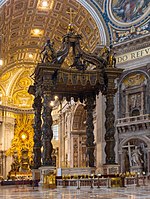Papal tombs in old St. Peter's Basilica
Burials at St. Peter's BasilicaHistory of the papacyPapal tombsSarcophagi

The papal tombs in old St. Peter's Basilica were the final resting places of the popes, most of which dated from the fifth to sixteenth centuries. The majority of these tombs were destroyed during the sixteenth through seventeenth century demolition of old St. Peter's Basilica, except for one which was destroyed during the Saracen Sack of the church in 846. The remainder were transferred in part to new St. Peter's Basilica, which stands on the site of the original basilica, and a handful of other churches of Rome.
Excerpt from the Wikipedia article Papal tombs in old St. Peter's Basilica (License: CC BY-SA 3.0, Authors, Images).Papal tombs in old St. Peter's Basilica
Sakristeistraße,
Geographical coordinates (GPS) Address Phone number Website Nearby Places Show on map
Geographical coordinates (GPS)
| Latitude | Longitude |
|---|---|
| N 41.9022 ° | E 12.4533 ° |
Address
Basilica di San Pietro (Basilica di San Pietro in Vaticano)
Sakristeistraße
00120 , Vatican City
Vatican City
Open on Google Maps








